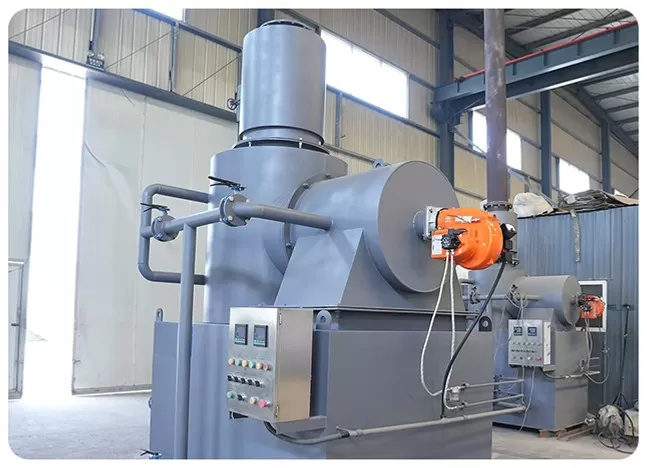Today's industrial waste combustion furnace has three major scoring standards: ① grate type; ② grate movement methods and strength; ③ grate inclination and waste in the direction of the movement of the grate surface, etc.; the three scoring standards over the top, in order to ensure that the waste in a timely manner point with the full combustion and combustion of the grate should be divided into red monotonous and point with the area, the main combustion zone and ash combustion area of the three regions;
Industrial waste combustion furnace technology has now experienced almost 130 years of development process, industrial waste combustion furnace technology and equipment has been perfected and widely used. Western developed countries now common waste combustion system has the following categories:
(1) waste layer combustion combustion system, such as the use of tumbling grate, horizontal reciprocating feed grate and tilting reciprocating grate (including push and reverse push tilting reciprocating grate) and so on. Layer combustion combustion method is characterized by the primary waste without severe pretreatment. Tumbling grate and reciprocating grate dial fire role is strong, compared to adapt to the low calorific value, high ash content of municipal waste combustion;
(2) fluidized bed combustion system, which is characterized by the suspension of waste combustion, air and waste full contact, combustion effect is good. However, the fluidized bed combustion needs more uniform particle size of the fuel, together with the plea for fuel feeding uniformity, so it is generally difficult to burn large pieces of waste, so the fluidized bed combustion system on the waste pre-treatment plea is severe, which bound its industrial waste and municipal waste combustion in the field of the development of the field;

(3) rotating cylinder combustion furnace, which is characterized by the waste into a continuous, slow-rolling cylinder burning until combustion, so it can complete the excellent contact between the waste and the air and the uniformity of the full combustion. Western countries will be more of this type of combustion furnace for toxic and hazardous industrial waste treatment.
In today's highly industrialized era, municipal industrial waste combustion furnace technology is facing many new situations and new problems:
1. In economically developed countries, municipal waste accumulation density is small, high calorific value and low ash and moisture;
2. Waste combustion emission standards are becoming more and more severe, especially the plea for useful control of the emission of hazardous substances in the flue gas. In addition to soot, waste combustion flue gas in the primary harmful substances are CO, SOx, NOx, organic carbon and dioxin (miscellaneous) dioxin (dioxins) and furan (furane). By improving combustion technology and adjusting the combustion process, the occurrence and emission of these substances can be controlled to a certain extent. In comparison, in the 1950s only the soot emissions and the minimum combustion temperatures of waste combustion furnaces were regulated. The minimum combustion temperature (e.g., 800°C) is intended to fully combust hazardous substances with irritating odors in the furnace;
3. from the point of view of combustion furnace funding and work economy, its minimum combustion should be 3t / h to 20 ~ 25t / h. Therefore, the modern waste laminar combustion combustion system should be satisfied with the following pleas:
(1) the role of a strong fire to ensure that all the grate surface waste uniformity, full combustion and avoid slagging. The primary factors affecting the role of the grate flare are: ① grate type; ② grate movement methods and intensity; ③ grate angle and waste in the grate surface movement direction; in order to ensure that the waste in a timely manner with the point of full combustion and combustion, the grate should be divided into red monotonous and point of the area, the main combustion zone and ash combustion zone in three areas;
(3) combustion equipment should have to often occur in the waste composition (moisture or calorific value) suddenly appeared to adapt to the situation. When the waste composition is not firm, combustion furnace waste feed and primary air volume and its distribution and temperature should be timely and accurate to be dispatched;
(4) Preheating of combustion air (primary and secondary air);
(5) The possibility of putting in certain additives to reduce the emissions of certain hazardous substances such as dioxins, NOx and SOx;
(6) Dividing the entire combustion process into a period of waste combustion and a period of combustion of combustible hazardous substances in the flue gas, with the latter period requiring sufficient air for the combustion of the flue gas. In the waste combustion period need to bind the amount of combustion air, in order to avoid the furnace temperature of the drastic inconstancy as well as the occurrence of too much fly ash
(7) Ensure low carbon content of ash and fly ash (1 to 3%), excellent combustion.